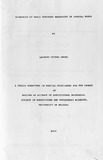| dc.description.abstract | The study was set to evaluate the marketing system of
small ruminants in coastal Kenya with the following
objectives: i) Identify factors related to commercial off take
in the study area, ii) estimate the marketing costs and
margins accruing to various marketing agents in the small
ruminant marketing chain, iii) test for existence of spatial
integration between different channel levels in the small
ruminant marketing chain.
A farm household survey of 76 households in Kaloleni
division of Kilifi District found farmers to own small
ruminants for sale to meet household subsistence requirements.
Seasonal cash need was identified as the main factor related
to sale of small ruminant in the household. In addition, a
survey of rural distributive markets and abattoirs serving the
study area identified five channel levels namely; (i)
producers (ii) assemblers (iii) itinerant traders (iv)
retailers, and (v) consumers in the marketing chain.
The analysis of marketing costs and margins indicated
rates of return on capital investment of about 15 percent per
head of small ruminant for assemblers. All itinerant traders
recorded less than 10 percent return per head save for Bamba-
Kasemeni channel that recorded about 20 percent. The
marketing cost varied between 9 and 15 percent of the
total cost per head in all the channels for itinerant traders.
Price correlation analysis showed the distributive
markets Bamba and Mariakani, Kinango and Mariakani, and Bamba
and Kinango to be integrated. All the abattoirs were
integrated in prices with respect to each other.
Bivariate regression results showed lack of integration
between Bamba distributive market and Mariakani abattoir.
Arbitrage cost was suggested between Bamba and Kasemeni
abattoir, Tsangatsini and Mariakani abattoir, as well as
Mariakani and Mariakani abattoir. All the abattoirs showed
integration with respect to each other.
In conclusion, the marketing system was both technically
and price efficient as shown by marketing margins and cost
analysis as well market integration evaluation. However,
further research on the marketing system of hides and skins
needs to be conducted. Bivariate regression analysis provided
results consistent with traders observations regarding
integration of distributive markets and the abattoirs. For
future studies, regression models such as the Ravallion model
that incorporates a vector of other significant market
determinants is suggested for more conclusive results. | en |

